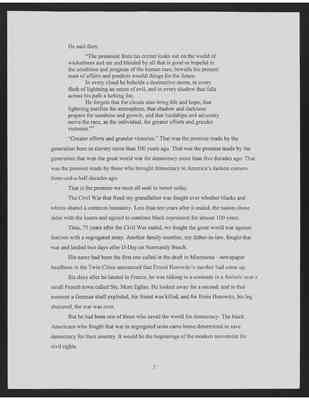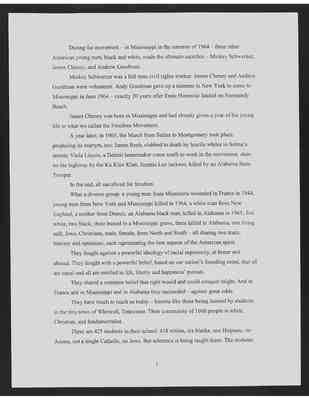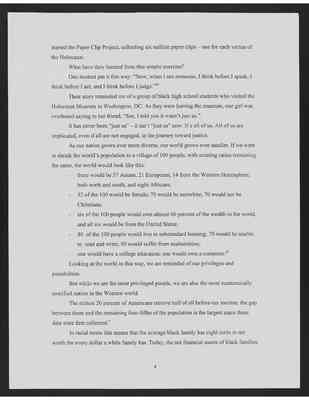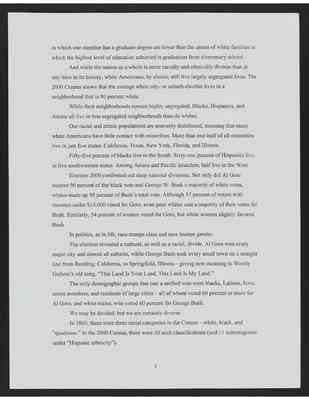Pages
1
DIVERSITY
Copyright 2001 by Julian Bond
COPY
Last month there was a New York Times article about the design of the spa at this resort.
The architect, Richard Gluckman, was quoted as saying, "We wanted to reflect the gradations in color of the canyon wall, which goes from a deep rust color at the base to an almost white at the cliff edge."
I want to reflect - and reflect on - the color gradations of our nation's people and how they, together with their corresponding multicultures, like Mr. Gluckman's spa, complement and enhance our natural world.
In the NAACP, we like to say that colored people come in all colors. One of the colors in the spectrum is black, and although it comes in more than one shade, it usually connotes one history - a history of difference, discrimination, and, most often, slavery.
Like many others in this nation, I am the grandson of a slave.
My grandfather was born in 1863, in Kentucky; freedom did not come for him until after the 13th Amendment was ratified in 1865.
He and his mother were property, like a horse or a chair. As a young girl, she had been given away as a wedding present to a new bride, and when that bride became pregnant, her husband - that's my great-grandmother's owner and master - exercised his right to take his wife's slave as his mistress. That union produced two children - one of them my grandfather.
As a teenager, barely able to read and write, he hitched his tuition - a steer - to a rope and walked 100 miles across Kentucky to Berea College, and Berea took him in. 16 years later, he graduated, and the college asked him to deliver the commencement address.
1
2
He said then:
"The pessimist from his corner looks out on the world of wickedness and sin and blinded by all that is good or hopeful in the condition and progress of the human race, bewails the present state of affairs and predicts woeful things for the future.
In every cloud he beholds a destructive storm, in every flash of lightning and omen of evil, and in every shadow that falls across his path a lurking foe.
He forgets that the clouds also being life and hope, that lightning purifies the atmosphere, that shadow and darkness prepare for sunshine and growth, and that hardships and adversity nerve the race, as the individual, for greater efforts and grander victories."ii
"Greater efforts and grander victories." That was the promise made by the generation born in slavery more than 100 years ago. That was the promise made by the generation that won the great world war for democracy more than five decades ago. That was the promise made by those who brought democracy to America's darkest corners three-and-a half decades ago.
That is the promise we must all seek to honor today.
The Civil War that freed my grandfather was fought over whether blacks and whites shared a common humanity. Less than ten years after it ended, the nation chose sides with the losers and agreed to continue black repression for almost 100 years.
Thus, 75 years after the Civil War ended, we fought the great world war against fascism with a segregated army. Another family member, my father-in-law, fought that war and landed two days after D-Day on Normandy Beach.
His name had been the first one called in the draft in Minnesota - newspaper headlines in the Twin Cities announced that Ernest Horowitz's number had come up.
Six days after he landed in France, he was talking to a comrade in a foxhole near a small French town called Ste. Mere Eglise. He looked away for a second, and in that moment a German shell exploded, his friend was killed, and for Ernie Horowitz, his leg shattered, the war was over.
But he had been one of those who saved the world for democracy. The black Americans who fought that war in segregated units came home determined to save democracy for their country. It would be the beginnings of the modern movement for civil rights.
2
3
During the movement - in Mississippi in the summer of 1964 - three other American young men, black and white, made the ultimate sacrifice - Mickey Schwerner, James Cheney, and Andrew Goodman.
Mickey Schwerner was a full-time civil rights worker. James Cheney and Andrew Goodman were volunteers. Andy Goodman gave up a summer in New York to come to Mississippi in June 1964 - exactly 20 years after Ernie Horowitz landed on Normandy Beach.
James Cheney was born in Mississippi and had already given a year of his young life to what we called the Freedom Movement.
A year later, in 1965, the March from Selma to Montgomery took place, producing its martyrs, too: James Reeb, clubbed to death by hostile whites in Selma's streets; Viola Liuzzo, a Detroit homemaker come south to work in the movement, slain on the highway by the Ku Klux Klan; Jimmie Lee Jackson, killed by an Alabama State Trooper.
In the end, all sacrificed for freedom.
What a diverse group: a young man from Minnesota wounded in France in 1944, young men from New York and Mississippi killed in 1964, a white man from New England, a mother from Detroit, an Alabama black man, killed in Alabama in 1965; five white, two black; three buried in a Mississippi grave, three killed in Alabama, one living still; Jews, Christians, male, female, from North and South - all sharing two traits, bravery and optimism, each representing the best aspects of the American spirit.
They fought against a powerful ideology of racial superiority, at home and abroad. They fought with a powerful belief, based on our nation's founding creed, that all are equal and all are entitled to life, liberty and happiness' pursuit.
They shared a common belief that right would and could conquer might. And in France and in Mississippi and in Alabama they succeeded - against great odds.
They have much to teach us today - lessons like those being learned by students in the tiny town of Whitwell, Tennessee. Their community of 1600 people is white, Christian, and fundamentalist.
There are 425 students in their school: 418 whites, six blacks, one Hispanic, no Asians, not a single Catholic, no Jews. But tolerance is being taught there. The students
3
4
started the Paper Clip Project, collecting six million paper clips - one for each victim of the Holocaust.
What have they learned from this simple exercise?
One student put it this way: "Now, when I see someone, I think before I speak, I think before I act, and I think before I judge."iii
Their story reminded me of a group of black high school students who visited the Holocaust Museum in Washington, D.C. As they were leaving the museum, one girl was overheard saying to her friend, "See, I told you it wasn't just us."
It has never been "just us" - it isn't "just us" now. It's all of us. All of us are implicated, even if all are not engaged, in the journey toward justice.
As our nation grows ever more diverse, our world grows smaller. If we were to shrink the world's population to a village of 100 people, with existing ratios remaining the same, the world would look like this:
- there would be 57 Asians, 21 Europeans, 14 from the Western Hemisphere, both north and south, and eight Africans;
- 52 of the 100 would be female; 70 would be nonwhite; 70 would not be Christians;
- six of the 100 people would own almost 60 percent of the wealth in the world, and all six would be from the United States;
- 80 of the 100 people would live in substandard housing; 70 would be unable to read and write; 50 would suffer from malnutrition;
- one would have a college education; one would own a computer.iv
Looking at the world in this way, we are reminded of our privileges and possibilities.
But while we are the most privileged people, we are also the most economically stratified nation in the Western world.
The richest 20 percent of Americans receive half of all before-tax income; the gap between them and the remaining four-fifths of the population is the largest since these data were first collected.v
In racial terms this means that the average black family has eight cents in net worth for every dollar a white family has. Today, the net financial assets of black families
4
5
in which one member has a graduate degree are lower than the assets of white families in which the highest level of education achieved is graduation from elementary school.
And while the nation as a whole is more racially and ethnically diverse than at any time in its history, white Americans, by choice, still live largely segregated lives. The 2000 Census shows that the average white city- or suburb-dweller lives in a neighborhood that is 80 percent white.
While their neighborhoods remain highly segregated, Blacks, Hispanics, and Asians all live in less segregated neighborhoods than do whites.
Our racial and ethnic populations are unevenly distributed, meaning that many white Americans have lttle contact with minorities. More than one-half of all minorities live in just five states: California, Texas, New York, Florida, and Illinois.
Fifty-five percent of blacks live in the South. Sixty-one percent of Hispanics live in five southwestern states. Among Asians and Pacific Islanders, half live in the West.
Election 2000 confirmed out deep divisions. Not only did Al Gore receive 90 percent of the black vote and George W. Bush a majority of white votes, whites made up 95 percent of Bush's total vote. Although 57 percent of voters with incomes under $15,000 voted for Gore, even poor whites cast a majority of their votes for Bush. Similarly, 54 percent of women voted for Gore, but white women slightly favored Bush.
In politics, as in life, race trumps class and race trumps gender.
The election revealed a cultural, as well as a racial, divide. Al Gore won every major city and almost all suburbs, while George Bush took every small town on a straight line from Redding, California, to Springfield, Illinois - giving new meaning to Woody Guthrie's old song, "This Land Is Your Land, This Land Is My Land,"
The only demographic groups that cast a unified vote were blacks, Latinos, Jews, union membets, and residents of large cities - all of whom voted 60 percent or more for Al Gore, and white males, who voted 60 percent for George Bush.
We may be divided, but we are certainly diverse.
In 1860, there were three racial categories in the Census - white, black, and "quadroon." In the 2000 Census, there were 30 such classifications (and 11 subcategories under "Hispanic ethnicity").
5




